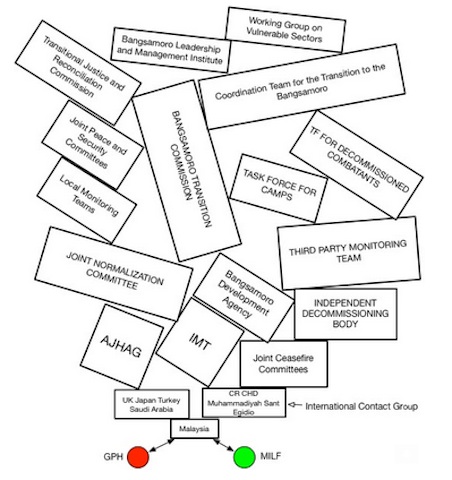The peace infrastructure between the Government of the Philippines and the Moro Islamic Liberation Front (MILF) is complicated and unstable. We need to make it simple and stable.
Not the parties’ fault. That the peace infrastructure is complicated and unstable is not the parties fault. This is because the architecture, as it were, grew in response to specific challenges and problems they encountered through the years. In local parlance, nanganak nang nanganak. The present architecture is the product of the parties responding to events as they happened and therefore, resulting in a complicated, unstable and less than effective architecture. Most of these bodies in the architecture are contained in signed agreements which makes it more difficult to change.
 Illustration courtesy of Bong Montesa
Illustration courtesy of Bong MontesaWe have more knowledge and wisdom now. But now the parties have the advantage of hindsight. They know what works and what did not work. When they signed the agreements and created bits of the architecture here and there they had little knowledge and experience. But now they have more knowledge and more experience. They can improve on things. It would be a pity if the parties would let the decisions they made when they had less knowledge and experience in the past determine and tie the success of the future. Decisions made with less information must give way to designs made with more information. A balanced fidelity to signed agreements and goal-centered effectiveness is required.
The fear, of course, is that to allow changes in architecture which are contained in signed agreements, even to make it more effective, opens the flood gates of possible changes in the substantive elements of the Comprehensive Agreement on the Bangsamoro (CAB). For some parties in peace negotiations, especially the weaker ones, a signed agreement is an insurance policy, a form of security. It is also a clear win, a gain. It is a prized possession. This is especially true if the trust level is low. It is this fear and distrust, I suspect, that will make the next few months a hard and tough time for the parties.
Right for negotiations phase but not anymore sufficient for implementation. The present architecture was good for the negotiations phase and the fruit of the pudding is the CAB. The architecture enabled and buoyed the parties to come up with the peace accord. But I think that architecture needs to be fine tuned and simplified it were to achieve the goals of the new phase – implementation of the CAB. What is good for negotiations might not be effective for implementation. The good thing about this is that both the Government and the MILF agree that the era of negotiations is over and that they are now in the implementation phase.
Challenge. How to simplify a complex negotiations infrastructure into a simple yet effective implementation infrastructure? This is really the challenge. If you take look at the diagram above, you will see that the current infrastructure is unstable and will collapse if the wrong decision or move is made. A lot of thinking and calculations must be made on the part of government and the MILF. Some strategic questions to ponder are:
- What will be the role of the third party facilitator in the implementation phase?
- What kind of structure will be put in place to make sure that the partnership and close coordination of the GPH and MILF continues?
- What will happen to the negotiation panels?
- If there are no negotiation panels, how will the parties collaborate with each other?
- What will be the roles of international community in the implementation?
- What will happen to the International Contact Group?
- Will the International Monitoring Team (IMT) continue on the ground?
- What will be the role of the Third Party Monitoring Team (TPMT)?
- How will this implementation be funded? Government funds? Foreign donor funds? Who will contribute? Who will manage?
- What parts of the architecture to keep? What not to keep?
http://www.mindanews.com/mindaviews/2016/06/10/peacetalk-complicated-peace-infrastructure/

No comments:
Post a Comment
Note: Only a member of this blog may post a comment.